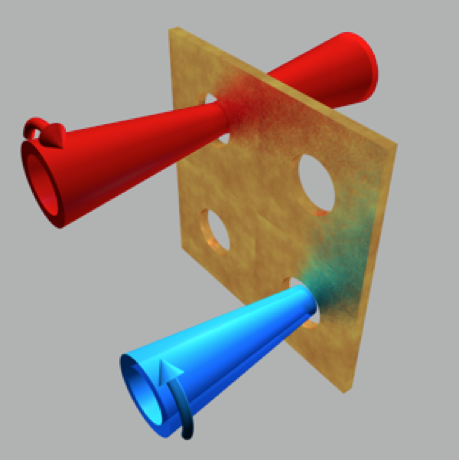Structured light make circular holes distinguish between left and right

(Phys.org) —A group of researchers at Macquarie University has shown that circular dichroism – a differential absorption of the circular polarization light – can be induced in mirror symmetric samples such as circular holes or spheres, if structured light is used.
Circular dichroism is a very common technique used in biomolecular sciences to distinguish between molecules which are chemically identical, but whose atoms are configured in mirror symmetric dispositions. The presence of circular dichroism in a solution of molecules has been traditionally associated with chirality, i.e. that the molecules in the solution are not mirror symmetric. The counterintuitive finding is an important step in developing the precision with which scientists observe physical phenomena.
The research group used a special set of laser beams called vortex beams, which demonstrate either right or left circular polarisation and are not mirror symmetric. This contrasts with the typical light beams used for circular dichroism measurements.
In these measurements, the electric field in a right circularly polarized beam rotates clockwise, while the left circular polarization counterpart will rotate anticlockwise. However, in the vortex beams used in this experiment, the electric field in the left circular polarization rotated clockwise, but the one in the right circular polarization did not rotate at all.
Researchers Dr Zambrana-Puyalto and Dr Vidal were surprised to observe that when changing the polarization from right to left, the vortex beam transmission through a small hole changed dramatically.
"The ratios between the transmission of the two polarizations in some holes was almost 100 to 1," said Dr Vidal. "This is a case of extreme circular dichroism, and we observed it in a completely mirror symmetric structure, which defied our intuition."
The circular hole can distinguish between the right and left circularly polarized vortex beams. While one is partially transmitted, the other was almost completely blocked.
"What these experiments clearly show is that there is a wealth of information that can be retrieved from the circular dichroism measurements, which are routinely done in chemical laboratories, by cleverly patterning the spatial structure of the light beams used," said lead researcher Associate Professor Molina-Terriza.
The method developed at Macquarie University reveals information of the nanostructure, which is typically hidden to other kind of measurements.
"We see it as a change of paradigm. Lots of people are trying to control light at the nanoscale, by carefully fabricating complex structures. We think that in some applications it is easier to use simple structures and light beams with a complex structure," said Dr Zambrana-Puyalto.
These applications include optical processors using metallic circuits, extremely sensitive sensors for biomolecular detection or controlling the quantum properties of macroscopic objects.
More information: "Angular momentum-induced circular dichroism in non-chiral nanostructures," Nature Communications, 12 September 2014, X.Vidal, X. Zambrana-Puyalto, G. Molina-Terriza DOI: 10.1038/ncomms5922
Journal information: Nature Communications
Provided by Macquarie University




















